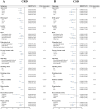The Association Between Dietary Fiber Intake and Depression Among US Adults: A Cross-Sectional Study Based on NHANES Data From 2005 to 2020
- PMID: 40678325
- PMCID: PMC12267881
- DOI: 10.1002/fsn3.70605
The Association Between Dietary Fiber Intake and Depression Among US Adults: A Cross-Sectional Study Based on NHANES Data From 2005 to 2020
Abstract
Depression is a prevalent chronic condition that affects a person's thoughts, emotions, and physical health. However, there is limited evidence on the impact of dietary fiber on depression. Additionally, the association between dietary fiber intake and the risk of depression remains controversial. We extracted data from the National Health and Nutrition Examination Survey (NHANES) database on 85,750 participants. After excluding minors and pregnant individuals, and those with missing Patient Health Questionnaire-9 (PHQ-9) data, dietary fiber intake, or covariates, we included 29,980 participants for data analysis. Categorizing them into non-depressed groups, clinically relevant depression (CRD, with scores no less than 10) and clinically significant depression (CSD, with scores no less than 15) is determined based on PHQ-9 scores. We employed survey-weighted generalized linear models, and restricted cubic spline (RCS) curves are employed to judge the significance of the correlation of dietary fiber intake and risk of developing CRD and CSD. Finally, we conducted subgroup analyses using stratified weighted multiple regression analysis. The manuscript was organized according to STROBE guidelines. There exists a non-linear inverse relationship between dietary fiber intake and the incidence of CRD and CSD. In the model after full adjustment, compared to individuals in the first quartile, the probability of CRD was reduced by 17%, 22%, and 30% respectively for those in the second, third, and fourth quartiles (odds ratios [OR] = 0.70; 95% confidence interval [95% CI]: 0.57-0.85, p < 0.001); the risk of CSD was reduced by 22%, 40%, and 32% (OR = 0.68; 95% CI: 0.48-0.94, p = 0.02). RCS curves indicate an L-shaped nonlinear connection existing between dietary fiber consumption and both CRD and CSD. Subgroup analysis strengthens the stability of the conclusions. There is a nonlinear negative relationship of dietary fiber intake and the risk of CRD and CSD, with a nonlinear L-shaped relationship between dietary fiber intake and both CRD and CSD.
Keywords: CRD; CSD; NHANES; depression; dietary fiber.
© 2025 The Author(s). Food Science & Nutrition published by Wiley Periodicals LLC.
Conflict of interest statement
The authors declare no conflicts of interest.
Figures




Similar articles
-
The relationship between flavonols intake and stroke in the elderly: a cross-sectional study from NHANES (2007-2010 and 2017-2018).J Stroke Cerebrovasc Dis. 2025 Aug;34(8):108373. doi: 10.1016/j.jstrokecerebrovasdis.2025.108373. Epub 2025 Jun 7. J Stroke Cerebrovasc Dis. 2025. PMID: 40490174
-
Association between dietary fiber intake and post-stroke depression among US women: insights from the NHANES 2005-2018 cross-sectional study.Front Nutr. 2025 Jul 29;12:1586511. doi: 10.3389/fnut.2025.1586511. eCollection 2025. Front Nutr. 2025. PMID: 40799518 Free PMC article.
-
Nutritional interventions for survivors of childhood cancer.Cochrane Database Syst Rev. 2016 Aug 22;2016(8):CD009678. doi: 10.1002/14651858.CD009678.pub2. Cochrane Database Syst Rev. 2016. PMID: 27545902 Free PMC article.
-
Inverse association between dietary fiber intake and gallstone disease in U.S. adults: a cross-sectional study from the NHANES database.Front Nutr. 2025 Jul 1;12:1624173. doi: 10.3389/fnut.2025.1624173. eCollection 2025. Front Nutr. 2025. PMID: 40667433 Free PMC article.
-
Sertindole for schizophrenia.Cochrane Database Syst Rev. 2005 Jul 20;2005(3):CD001715. doi: 10.1002/14651858.CD001715.pub2. Cochrane Database Syst Rev. 2005. PMID: 16034864 Free PMC article.
References
-
- Agus, A. , Planchais J., and Sokol H.. 2018. “Gut Microbiota Regulation of Tryptophan Metabolism in Health and Disease.” Cell Host & Microbe 23, no. 6: 716–724. - PubMed
-
- Baryshnikov, I. , Aledavood T., Rosenström T., et al. 2023. “Relationship Between Daily Rated Depression Symptom Severity and the Retrospective Self‐Report on PHQ‐9: A Prospective Ecological Momentary Assessment Study on 80 Psychiatric Outpatients.” Journal of Affective Disorders 324: 170–174. - PubMed
-
- Boden, J. M. , and Fergusson D. M.. 2011. “Alcohol and Depression.” Addiction 106, no. 5: 906–914. - PubMed
LinkOut - more resources
Full Text Sources

